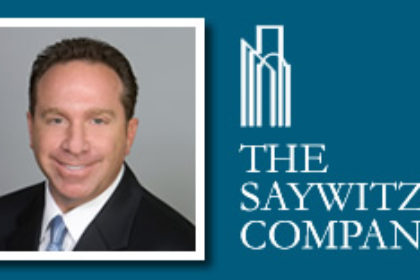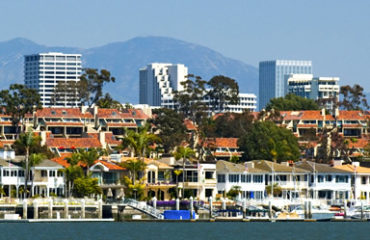
Being an entrepreneur is about envisioning a better way to do something, and then making the vision a reality. Sometimes, in the process, entrepreneurs create something new which becomes bigger than they could have imagined in their wildest dreams. Meet Barry Saywitz. “I’m not an entrepreneur who sat at home and thought up a great invention,” he says. “I took principles and concepts, and tried to expand on them and create a niche where I could be successful.”
Saywitz is founder and president of The Saywitz Company, a commercial real estate brokerage and consulting firm with 25 employees headquartered in Newport Beach. Recently, Saywitz was the youngest nominee on National Real Estate Investor Magazine’s list of the 40 most influential people in real estate underage 40.
Which means that he was only 26 when he got an entrepreneurial company off the ground during one of the worst real estate markets in recent history, and 27 when he started the CORE (Commercial Real Estate) Network, an I’ll help you-you help me umbrella organization pooling there sources of 80 plus commercial real estate firms with offices In more than 120 cities throughout the U.S.
Saywitz comes across as a wise 34-year-old, and maybe that’s because he’s achieved his success by dint of hard work and trial and error.He began his career as a commercial real estate broker in 1990 working for Howard Ecker and Company in Orange County. The office setup was Stone Age compared to today; three brokers shared two desks and a phone in an interior office of an executive suite no bigger than a closet. Although the early ’90s seem like recent history, the brokers had no computers to back them up, index cards were the high-tech tools of choice, and any pay they earned came from commission. Saywitz says, “It’s not a good feeling when you get down to your last couple of dollars. You don’t have 100 percent control over whether someone signs a deal.” Then, in 1992, the local real estate market hit bottom. At this not-so-opportune time, Saywitz became a partner in Howard Ecker, and in 1994 he bought the West Coast operations of the company and changed the name to The Saywitz Company.
The traditional method of building up business in commercial real estate has always involved exploiting personal connections. Saywitz thought there must be a better way to build a real estate business. “At the time,” he says, “I interviewed with other real estate brokerage companies throughout Southern California and asked them about their game plans. No one really had one in terms of developing business other than basing it on personal relationships. Since no one had a compelling plan, I decided to give it a try.” Because of the poor market conditions, Saywitz had chosen a difficult time to buy in. But he believed there had to be a process for cultivating and generating business other than playing golf. “When I started,” says Saywitz, “It was just me and a secretary. I’d go out in the morning and canvas buildings to generate prospects and leads. Then I would go back to the office and call on the leads, and later, in the evening, send out follow-up letters and information.”
“I taught myself how to use a computer and type out of necessity. I would go home at 2 a.m. and comeback to work at 6 a.m.” The more information Saywitz gleaned the more he saw that, especially at that time, it was a tenant’s market. So he concentrated on representing tenants. But he wasn’t content to stop at developing a focused process of target marketing to grow his client base.
As his company grew, he realized that in a typical real estate company, each broker functioned essentially as a company within a company. A broker was responsible for all aspects of his business; cultivating leads, turning them into clients, closing the transactions, and starting over. Saywitz found this inefficient. “I was strong in all these areas,” he says, “but operating like that was not a good use of my time. So I decided to structure my company more like a corporation.” The Saywitz Company has a research department to procure leads and prospects, a marketing department cultivating new business, brokers to work on the transactions, and a technical and administrative support department.
Saywitz’s next and most far-reaching innovation came when his company began to deal with large companies with a national presence. A client they were representing in Southern California would come to them and ask, “What do you know about Atlanta?” While general real estate knowledge is similar throughout the United States, there’s no substitute for expertise in the local market. Being a local Southern California company suddenly had its limitations, since they were competing with larger national real estate companies for business. So the Saywitz Company would engage the services of a local company in brokering the deal. But often, the local company they hooked up with would turn out to be part of a competitor company, or we would get some junior guy working on our deal. “In 1996,” says Saywitz, “I saw I needed to develop a platform to expand our business on a national basis. This would help us compete both nationally and locally, and help us give our clients what they needed. ”
Saywitz looked at other national organizations for ideas, hiring one of the former heads of real estate for Bank of America to analyze how other companies went about obtaining and servicing national business between cities. Saywitz’s model incorporated the best ideas from each. Together with a Los Angeles real estate firm, he developed the CORE network, a mutual benefit, nonprofit organization similar to the NFL in structure. He identified cities where he wanted an affiliate partner, starting with a list of 600 local entrepreneurial firms compatible with the CORE network’s goals. Clearly, he had struck a common nerve, as almost every single firm he contacted elected to participate. After a recent merger, CORE is now the sixth largest real estate brokerage organization in the country, conducting $17 billion in transactions in 2001, and Saywitz now serves as Chairman.
His next challenge was figuring out how to weather the ups and downs of the real estate market. “It’s difficult for those with monthly obligations to be in this type of industry,” says Saywitz. So he determined he would convert his success in the brokerage business into a solid monthly cash flow by purchasing multi-family investment properties with his profits. “It’s nice to be a landlord,” he says. The rent creates cash flow, which can supplement or offset the ups and downs in the brokerage business. Today, the Saywitz Company has a separate division, which buys multi-family apartment buildings near the beach, a construction crew that renovates them, and a division to manage them and handle the leasing.
Never afraid to try something new, Saywitz feels his biggest gamble so far was going out on his own during the worst economic times, with no real mentor or company structure to support him. “In facing all those first-time issues,” says Saywitz, “I made some mistakes. I try to share those with others so they don’t make the same mistakes.” His goal for The Saywitz Company is to grow to the point where it is a consistent force in the marketplace. By refusing to accept the status quo, Barry Saywitz has managed to create not only a strong local company with a wide national reach, but a nation wide network of affiliates working together to keep their clients happy. But don’t take your eyes off him yet…as young as he is, there are certainly more innovations to come.


